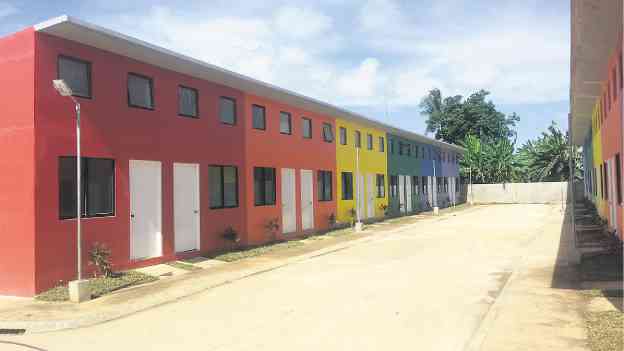Resolving the unsettling housing problem

The government’s relocation plan for illegal settler families (ISFs) living along identified danger zones was approved in 2011.
Among the housing programs of the Aquino administration were two flagship projects: one for informal settlers residing in dangerous areas in Metro Manila, and another for the uniformed men and women of the military and police.
The government relocation plan for illegal settler families (ISFs) living along identified danger zones was approved in 2011. Their relocation to safe, decent, and affordable resettlement sites was also done in preparation for the onset of the rainy season as it would clear waterways, esteros and other structures where ISFs abound.
A P50 billion budget was allotted for the project and the goal was to relocate and provide homes to around 104,000 ISFs, of which 60,000 were living in waterways or esteros. The program aims to relocate 20,000 families yearly.
For low income personnel
Also approved in 2011 was a five-year program intended to provide permanent housing facilities for low-income military and police personnel.
Article continues after this advertisementThe program was pursued under Administrative Order No. 9 and it mandates the formulation, implementation, and management of housing projects for the Armed Forces of the Philippines (AFP), Philippine National Police (PNP), Bureau of Jail Management and Penology (BJMP), and the Bureau of Fire Protection (BFP) personnel.
Article continues after this advertisementUnder this program’s 30-year amortization schedule, the personnel will only have to shell out some P200 monthly for the first four years, with the amount rising to P1,330 on the 30th year. As of June 2015, a total of 57,328 housing units have been completed.
According to the National Housing Authority (NHA), the more than 5,200 housing units from Pandi and San Jose del Monte Resettlement Sites in Bulacan that the Kalipunan ng Damayang Mahihirap (Kadamay) illegally occupied in March were meant for low-salaried uniformed personnel and Metro Manila ISFs living along danger zones.
Days after the illegal occupancy, President Duterte announced he would give for free the housing units in Bulacan to Kadamay members whose only sin, he said, was being poor.
The President also promised to build better houses for members of the police and the military by December.
The NHA had initially declared that they would have to evict the illegal occupants.
Last April 18, however, the Congress said it would come out with a joint resolution allowing the NHA to “re-award” the more than 50,000 unoccupied housing units that were intended for military and police personnel to four sectors, that included informal settlers and members of the Kadamay.
The housing program for the military and police has reportedly not attracted the beneficiaries because they found the homes too small—a floor area of 22 sqm on a 36-sqm lot worth P175,000; and a floor area of 18-27 sqm on a 40-sqm lot, worth P208,000.
Providing affordable homes
It can be recalled that in August 2016, the NHA reiterated its commitment to provide adequate and affordable housing to low-income and underprivileged families, as it emphasized the eligibility requirements for the beneficiaries.
“The NHA under the Duterte Administration ensures the public that it will address the country’s housing needs as it will lead the construction and development of new communities and maximize government resources,” NHA Acting General Manager Marcelino P. Escalada, Jr. was earlier quoted as saying.
This was on the back of the national government’s thrust to prioritize housing programs under the six-year Philippine Development Plan (PDP).
The NHA also emphasized that its housing program caters to the lowest 30 percent, the poorest of the urban population. It is mandated to provide housing and related assistance to ISFs living along danger zones and areas affected by government infrastructure projects.
To avail of government housing, the beneficiaries shoud met a set criteria.
According to NHA, the beneficiaries must be a Filipino citizen; an underprivileged and homeless citizen; must not own any real property whether in the urban or rural areas, and; must not be a professional squatter or a member of squatting syndicates.